April 28, 2022
Trademark News
The Tokyo District Court dismissed Christian Louboutin’s unfair competition claim against a third party’s black high heels with red soles.
The plaintiffs (the “Plaintiffs”) are a French fashion designer Christian Louboutin and his company whose high-end footwear with red lacquer-coated soles has become his signature. The defendant (the “Defendant”) is a Japanese women’s footwear brand, which produces and sells black high heels with red soles. The Plaintiffs claimed unfair competition against Defendant’s high heels, saying that the soles of the Defendant’s high heels are similar to their iconic red soles and filed a lawsuit seeking an injunction against production and sale of them, and damages before the Tokyo District Court (the “Court”). The Court dismissed the Plaintiffs’ claims (Tokyo District Court judgement, March 11, 2022 (Case number: 2019 (wa) 11108).
Background
The Plaintiffs are a French fashion designer Christian Louboutin and his company Christian Louboutin SAS. The designer has used a red color (PANTONE 18-1663TPG, the “Plaintiffs’ Red”) for high heels since 1997. Soles of the Plaintiffs’ high heels are made of leather and lacquer-coated in the Plaintiffs’ Red, which have become one of the features of the Plaintiffs’ footwear.
The Plaintiff designer filed a trademark application for the Plaintiffs’ Red used for soles of high heels with the Japan Patent Office (the “JPO”) in 2015 (App. No. 2015-29921), which was rejected for lack of distinctiveness and currently under appeal trial (as of April 26, 2022).
[Plaintiffs’ High Heels]

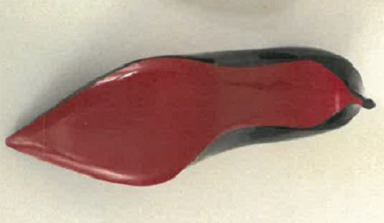
https://www.courts.go.jp/app/files/hanrei_jp/030/091030_hanrei.pdf
The Defendant is a Japanese women’s footwear brand. Since around 2018, the Defendant has produced and sold several types of black high heels with red soles (the “Defendant’s High Heels”) via online stores, department stores, etc. Those soles are made of rubber, and the Defendant’s brand name “EIZO” is printed in gold on them.
[Defendant’s High Heels]
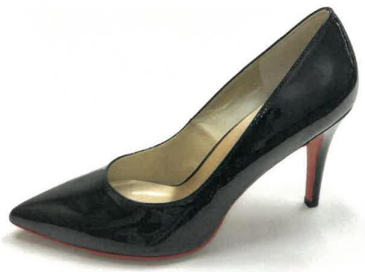
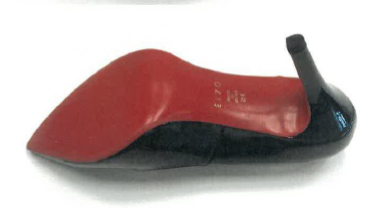
https://www.courts.go.jp/app/files/hanrei_jp/030/091030_hanrei.pdf
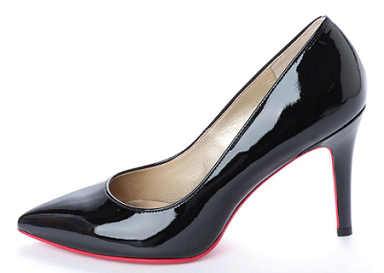
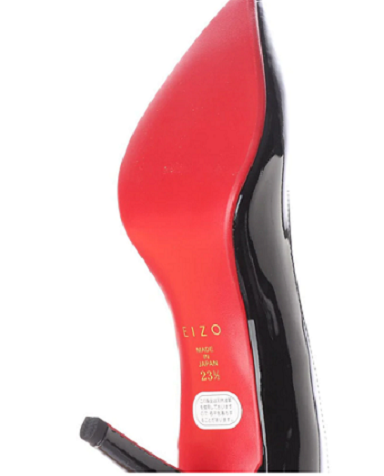
From the Defendant’s online store
The Plaintiffs claimed unfair competition against the production and sale of the Defendant’s High Heels asserting that a color similar to the following indication of the Plaintiffs’ goods (the “Indication of Plaintiffs’ Goods”) is used for their soles, and thus production and sale of them cause confusion with the Plaintiffs’ High Heels (Articles 2I(i) and (ii) of the Unfair Competition Prevention Act (the “UCPA”)). The Plaintiffs filed a lawsuit seeking an injunction against production and sale of them, and damages caused by sale of them.
[Indication of Plaintiffs’ Goods claimed by Plaintiffs]
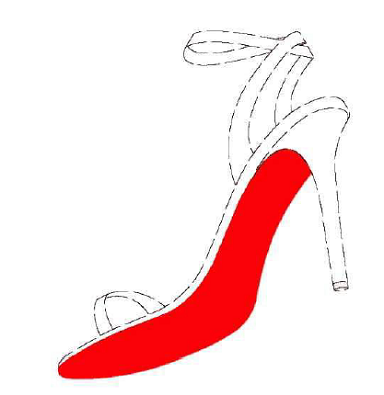
* The Indication of Plaintiffs’ Goods consists of a red color (PANTONE 18-1663TPG) used for high heel soles.
Court Judgment
The Court ruled that as a configuration of goods including colors did not basically serve as a source indicator of goods, it should only be acknowledged as an indication of the origin of goods protected under the UCPA when it had distinctive features and had become well-known as a source indicator through extensive use of it. Further, the Court remarked that when an indication of goods included multiple kinds of configurations, only some of which were found to be an indication of the origin of goods under the UCPA, it might impede fair competition and lead to a chilling effect on creative activities to acknowledge unfair competition claim against the whole kinds of configurations including those not serving as an indication of the origin of goods.
With respect to the Indication of Plaintiffs’ Goods claimed by the Plaintiffs, the Court found that it was merely identified as the red color (PANTONE 18-1663TPG) used for high heel soles and not specified in other elements such as the shape of heels, gloss, texture, colors of other parts of high heels. Accordingly, the Indication of Plaintiffs’ Goods claimed by the Plaintiffs was found to include a wide range and number of kinds of configurations of goods (including not only the Plaintiffs’ High Heels but also those of the Defendant).
Based on the results of inspections of both high heels, the Court found that the Plaintiffs’ High Heel soles were made of leather and in shiny lacquered red which made them characteristic whereas the Defendant’s High Heel soles were made of rubber and in mat red. Focusing on these differences, the Court found that red colored soles of the Defendant were obviously different from the Plaintiffs’ High Heels. The Court then concluded that the Defendant’s High Heels with red rubber soles, which were included in the Indication of Plaintiffs’ Goods claimed by the Plaintiffs, had not become well-known as a source indicator of the Plaintiffs’ High Heels, and thus the overall Indication of Plaintiffs’ Goods claimed by the Plaintiffs which included a wide variety of configurations should not be found to be an indication of the origin of the Plaintiffs’ goods under the UCPA.
Additionally, the Court pointed out that the Plaintiffs’ Red had been often used in the fashion industry and the Indication of Plaintiffs’ Goods should not be found to be distinctive. The Court also concluded that both high heels should not be confused with each other because consumers would be able to distinguish one from another by differences in color, shape, price range (the Plaintiffs’ High Heels cost over JPY 80,000 whereas the Defendant’s High Heels cost around JPY 17,000), etc.
Consequently, the Court dismissed the Plaintiffs’ claims.
Comments
As mentioned above, the trademark application for the Plaintiffs’ Red used for high heel soles was rejected and is currently under appeal trial against the examiner’s decision. This application was filed at the time when the JPO began to accept trademark applications for marks consisting of color alone. However, while some trademarks consisting of multiple colors got registered, none of those consisting of a single color has been registered yet.
This judgment says the range of the Indication of Plaintiffs’ Goods claimed by the Plaintiffs is too wide to be protected against others’ products like the Defendant’s High Heels. In general, the UCPA covers wider range of IP issues such as protection of unregistered rights and protection against parody that is unlikely to constitute trademark infringement, which may lead to protection against free riding and dilution. However, when it comes to colors, because they are primarily used for aesthetic purposes, hurdles to be protected as a source indicator will be higher. Based on the criteria of the judgment, it would also be quite hard for the trademark application to overcome the hurdles to get registered.
Written by: Ms. Tomoko Honami (Attorney at Law)